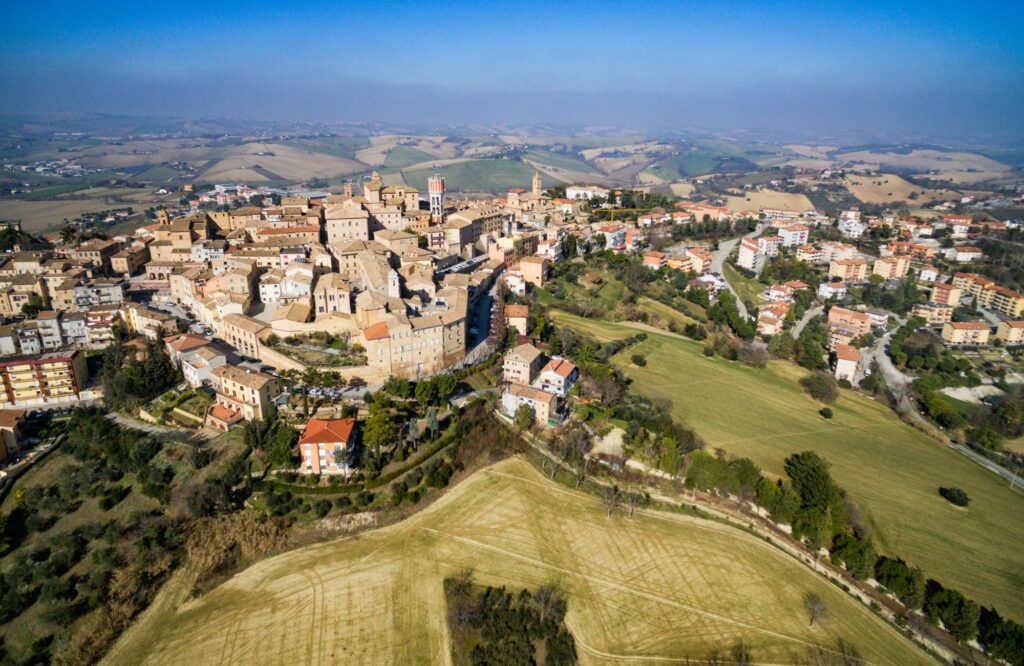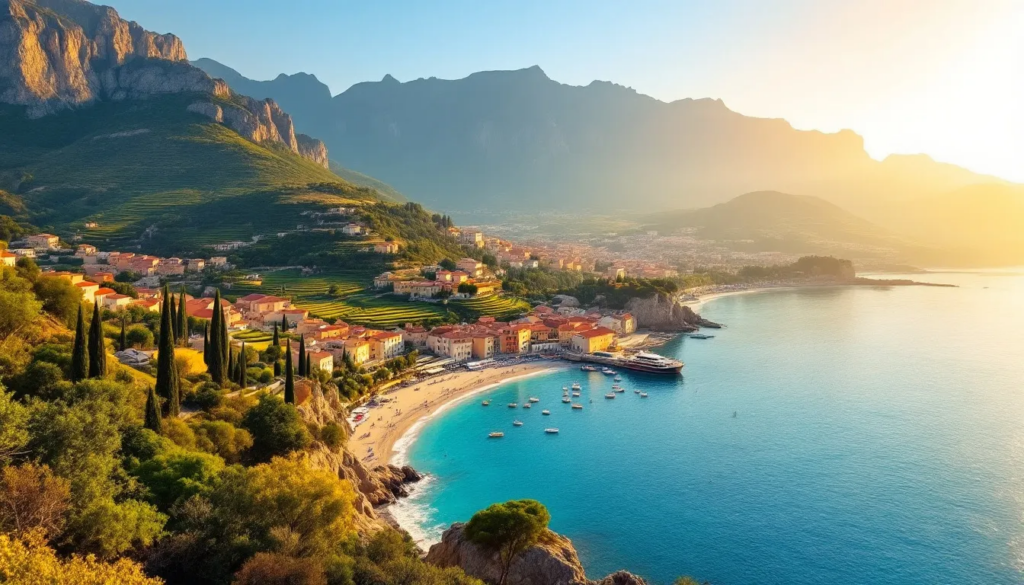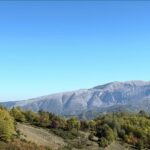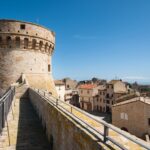Exploring the medieval villages of Le Marche offers something rare in Italy: authentic history without the crowds. This region in central Italy is dotted with fortified towns, stone houses, Renaissance palaces, and narrow streets that have barely changed since the Middle Ages. Le Marche is also home to many charming villages, known for their picturesque settings, historical architecture, and authentic atmosphere that capture the essence of Italian heritage. If you want to experience Italy through quiet hilltop villages, sweeping views, and local culture, Le Marche is one of the country’s best-kept secrets. With True Colors of Italy, you can explore these hidden gems on private, all-inclusive day tours curated for travelers who want depth, comfort, and insider knowledge.
If you’re dreaming of an intimate and immersive way to experience Italy, you can book a private medieval-village tour with us today.
Why Le Marche in Central Italy Is Home to Italy’s Most Beautiful Medieval Villages
The medieval villages of Le Marche stand out because they preserve centuries of history while offering a quiet alternative to Italy’s busier destinations. Many of these hilltop villages date back to Roman times and were transformed during the Middle Ages into fortified communities meant to protect residents from conflict and invasions. Their ancient origins, stone houses, ghibelline battlements, town walls, and bell towers show how daily life looked between the fourteenth century and the Renaissance period.
The region’s geography also shaped its character. Le Marche stretches from the Adriatic Coast to the Sibillini Mountains, creating a landscape of rolling hills, olive groves, and panoramic views. Villages were built on hilltops for defense and visibility, which is why so many towns today offer splendid views over valleys, vineyards, and national park terrain. The region is divided into five provinces, each contributing unique landscapes, attractions, and historical highlights that together define the diverse identity of Le Marche.
Unlike Tuscany or Umbria, the Marche region remains one of the least crowded places in Italy. You can walk through old towns, visit small churches like Santa Maria Assunta or San Francesco, or tour palaces such as Palazzo dei Priori and Palazzo della Signoria without navigating heavy crowds. Many villages also host cultural events, reenactments in period clothing, and local food festivals celebrating regional products such as truffles, local wines, and olive oil.
Top Medieval Villages to Visit in Le Marche
The medieval villages of Le Marche each carry a unique blend of history, architecture, and atmosphere. Below are some of the most remarkable villages to include on your itinerary. These places combine archaeological value, Renaissance heritage, and scenic beauty that bring Italy’s past to life.
Before the list, here are a few features many of these villages share:
They boast intact city walls, old town centers, and ancient walls that bear witness to centuries of shifting rulers, including the Romans, the medieval lords, and even Emperor Frederick II. Many villages also display Renaissance architecture linked to figures like Giovanni della Rovere, Francesco di Giorgio Martini, and Federico da Montefeltro, whose influence shaped the region’s palaces and civic spaces.
Offida
Offida is one of Le Marche’s most enchanting medieval villages, known for its striking hilltop location, intricate stonework, and the iconic Church of Santa Maria della Rocca. The town boasts beautiful views, quiet alleys, and artisan workshops where lace-making traditions continue today. Offida is also recognized with the Orange Flag, awarded to towns with excellent hospitality and preservation. Walking through its historic center offers a magical atmosphere, especially during the summer months when cultural events fill the piazzas.
Moresco
Moresco is a tiny village with a seven-sided medieval tower that dominates the skyline. Its ancient origins trace back to the Middle Ages, and its medieval layout remains almost untouched. The village’s position offers a panoramic view stretching from the Adriatic Sea to the Sibillini Mountains. Moresco is listed among the Most Beautiful Villages of Italy, earning the prestigious Orange Flag for its cultural richness and charm.
Sarnano
Sarnano is a well-preserved medieval village built entirely from local stone. Its old town spirals clockwise up a hill, forming a harmonious layout unchanged since medieval times. The village offers thermal baths, Renaissance architecture, and easy access to Monti Sibillini National Park. Travelers seeking medieval charm and outdoor exploration will find Sarnano an ideal destination.
Ascoli Piceno
Although larger than many nearby villages, Ascoli Piceno retains the atmosphere of a medieval and Renaissance city. Its historic center features the grand Piazza del Popolo, Roman bridges, Palazzo dei Capitani, and churches like San Francesco. The city walls and travertine buildings reflect its past as a powerful Roman city that evolved through medieval times into a Renaissance jewel. Ascoli is one of the easiest places to reach from the coast and pairs well with other village visits.
Cingoli
Cingoli, known as the “Balcony of the Marche,” sits high above sea level and offers expansive views across the region. Its Renaissance palaces, stone houses, and medieval town hall speak to centuries of culture and artistic patronage. The peaceful streets and cozy squares give it a romantic, small-village feel, perfect for slow exploration.
What Makes a Village ‘Medieval’ in Le Marche
A village is considered “medieval” when its architectural core, layout, and cultural identity date primarily from the Middle Ages. Many of the medieval villages in Le Marche feature defensive structures such as ancient walls, guard towers, and gates designed to protect residents from invaders. These towns often developed circular or spiral plans centered on a main piazza, a church, or a town hall like the Palazzo Comunale.
In many of these locations, Renaissance and Baroque additions blend with medieval foundations, creating a layered architectural story. Buildings such as the Ducal Palace, Diocesan Museum, and municipal art gallery often house or are housed with artifacts and collections from various historical periods. This unique blend makes the Marche region one of the richest areas in Italy for travelers seeking an immersive journey into ancient and medieval history.
How to Explore the Best Medieval Villages Near San Benedetto del Tronto
San Benedetto del Tronto is one of the region’s most convenient coastal bases for exploring nearby medieval villages. A short drive inland takes you to hilltop villages such as Offida, Moresco, Cingoli, and Ascoli Piceno, each offering its own blend of history, art, and exceptional food.
Many travelers prefer to explore independently, but navigating narrow hillside roads, limited parking, and local schedules can be challenging for first-time visitors. With True Colors of Italy, travelers can experience these locations through private guided tours that include transportation, dining, cultural explanations, and customized routing based on your pace and interests.
If you want a comfortable, stress-free way to explore the medieval villages of Le Marche, you can book one of our curated day tours from San Benedetto del Tronto.
Local Products and Cuisine of Le Marche’s Medieval Villages
A Culinary Landscape Shaped by Nature
The medieval villages of Le Marche sit among central Italy’s rolling hills and olive groves. They offer a culinary journey as rich as their ancient origins. Sun-drenched vineyards, fertile valleys, and hilltop villages produce a bounty of local products cherished for centuries. As you wander the narrow streets of villages like San Ginesio or Sarnano, you encounter stone houses and bustling piazzas full of hospitality and authentic cuisine.
Wines of the Region
Le Marche produces renowned local wines, and the town of Jesi shines for its crisp Verdicchio, a white wine that perfectly complements the region’s seafood specialties, such as Brodetto di Pesce from the Adriatic coast. Visitors also savor other celebrated varietals, including Rosso Piceno and Lacrima di Morro D’Alba, while enjoying splendid views from a hilltop terrace or a leisurely meal in a historic town center.
Hearty Local Dishes
The region’s culinary richness is also reflected in its hearty dishes. Vincisgrassi, a decadent baked pasta layered with meat and béchamel, is a beloved specialty that speaks to the Marche region’s unique blend of influences from the Middle Ages and the Renaissance period. Porchetta, a fragrant, herb-stuffed roast pork, is a staple at village festivals and open-air markets, especially during the lively summer months when cultural events fill the old town squares.
Urbino: Art, History, and Food
Urbino, a UNESCO World Heritage Site, is not only a treasure trove of Renaissance architecture but also a hub for food lovers. The town hall in the Palazzo dei Priori and the municipal art gallery showcase the area’s artistic legacy, while local trattorias serve up traditional fare made from recipes passed down through generations. The Ducal Palace, with its grand halls and art collections, often hosts events that celebrate both the region’s history and its gastronomy.
Ascoli Piceno and Surrounding Villages
In Ascoli Piceno, interesting buildings like the Palazzo dei Priori and the Diocesan Museum fill the historic center, allowing visitors to immerse themselves in the town’s cultural heritage before sampling local delicacies in a cozy osteria. Surrounding villages, such as Offida and Ripatransone, attract visitors with their artisanal products and panoramic views, offering perfect stops to taste local cheeses, cured meats, and olive oil pressed from the region’s ancient groves.
Cuisine in the Sibillini Mountains
Beautiful villages like Castelsantangelo sul Nera nestle within the Sibillini Mountains National Park, and local chefs celebrate the connection between nature and cuisine in every dish. They highlight wild herbs, truffles, and mountain cheeses in the village fare, showcasing a deep bond between fresh local ingredients and traditional cooking methods.
Best Time to Visit Medieval Villages in Le Marche
The best time to visit the medieval villages of Le Marche is during the spring and fall. From April to June and September to early November, the region offers pleasant temperatures, clear skies, and fewer tourists. These seasons highlight the rolling hills, olive groves, and stone buildings at their most photogenic moments.
Summer can also be a great time to visit, especially if you enjoy cultural festivals, historical re-enactments (historical re) that bring medieval traditions to life, and community events in period clothing. However, the heat can be intense in some hilltop towns. Winter is quiet and atmospheric, with fewer crowds and a slower pace, though some attractions may operate on limited hours.
For travelers who prefer curated scheduling, True Colors of Italy can plan your visit according to weather, events, and local availability.
Conclusion
Exploring the medieval villages of Le Marche offers a rare chance to slow down and experience Italy at its most authentic. From stone-built hilltowns to Renaissance squares and centuries-old traditions, each village adds its own chapter to the region’s rich history. If you’re looking for a deeper way to connect with culture, landscape, and local stories, Le Marche is one of Italy’s most rewarding places to begin. For travelers who want a seamless, curated experience, True Colors of Italy can plan a personalized journey that brings the region’s medieval heritage to life with comfort, insight, and ease.
Looking to explore Italy’s medieval charm without the stress of planning? True Colors of Italy offers private, all-inclusive day tours that bring the history, culture, and landscapes of Le Marche’s most beautiful medieval villages to life. Whether you’re traveling solo or with a small group, our curated experiences are crafted for travelers who want depth, comfort, and genuine local insight. Contact us today to start planning your personalized journey through the hidden medieval heart of Italy.
FAQs
What are the best medieval villages in Le Marche to visit?
Some of the best medieval villages in Le Marche include Offida, Moresco, Sarnano, Ascoli Piceno, and Cingoli. Each village offers a distinct combination of medieval architecture, panoramic views, and cultural richness. Travelers who want a curated experience can join one of our private excursions, which highlight the most historic and scenic locations.
Why are the medieval villages of Le Marche worth exploring?
These villages are worth visiting because they provide an authentic and peaceful alternative to Italy’s more crowded historic cities. With ancient walls, Renaissance buildings, and centuries-old streets, they offer a rare window into medieval and Renaissance life. Exploring them with a local guide adds depth and context, especially when you want meaningful storytelling and cultural insight.
When is the best time to visit medieval villages in Le Marche?“
Spring and fall offer the best weather for exploring medieval villages, with mild temperatures and clear views. Summer is ideal for cultural events and outdoor festivals, while winter provides charm and quiet if you enjoy slow travel. If you want help choosing the perfect season, True Colors of Italy can plan a personalized itinerary for your trip.












